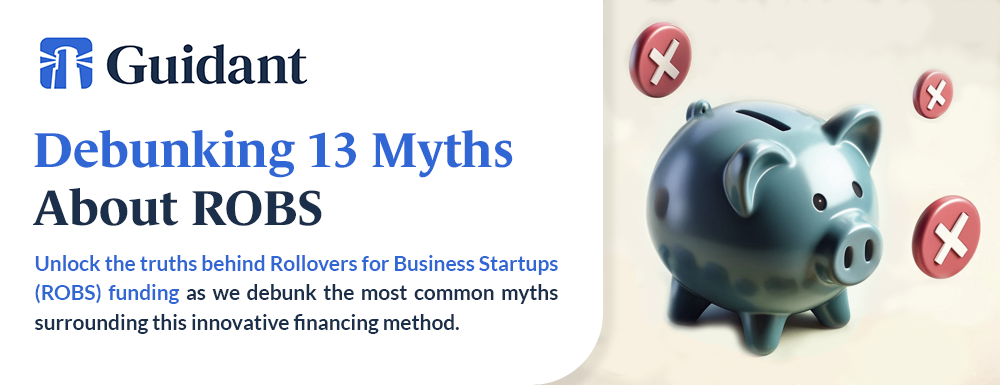

Debunking 13 of the Biggest Myths About ROBS
Unlock the truth about ROBS. Discover why entrepreneurs are turning to this financing option and dispel common myths

More and more entrepreneurs are using Rollovers for Business Startups — ROBS for short — to fund their dreams. In fact, over half of business owners surveyed in our Small Business Trends studyused ROBS to finance their businesses this year. Yet, it’s surprising how many current and aspiring small business owners believe all the wrong things about ROBS.
In what follows, we’ll dispel many of the biggest myths surrounding ROBS and demystify its complexities — all while clarifying the potential advantages of using ROBS. Let’s get started.
Do you qualify for ROBS? Answer These 5 Questions to see if you qualify now.
Debunking 13 ROBS Myths

Myth 1: ROBS Is a Loan
While loans and ROBS are both financing methods for business needs, ROBS is not a loan. ROBS utilizes your own retirement funds and creates a new retirement plan for your company that all employees can contribute to. If you obtain a loan, you’ll have to pay debt service every month. But because ROBS uses your own funds, you won’t have to pay debt service. It leaves your cash flow clear to be used in the business as you see fit.
Myth 2: ROBS Can’t Be Used with Every Type of Business
ROBS can be used with virtually every type of business and industry. The exception is that the business must be legal on the Federal level. So, for example, you could not fund a marijuana-based business even in states where marijuana is legal because it is not legal on the Federal level.
Myth 3: ROBS Can’t Be Used to Fund a Franchise
This one is totally untrue. ROBS has been used by thousands of franchisees to fund the initial purchase of a franchise, expansion of their franchise holdings and a myriad of business needs on the part of the franchisee. ROBS, unlike other some other forms of financing, can be used flexibly for either a franchise or a stand-alone business.
Myth 4: ROBS Is a Method of Tax Avoidance
ROBS is definitely not tax avoidance. This myth may derive in part from the tax treatment of the retirement funds used. Ordinarily, if you want to withdraw tax-advantaged retirement funds like 401(k)s and traditional Individual Retirement Accounts (IRAs) before the age of 59 1/2, the Internal Revenue Service (IRS) taxes the withdrawn funds and also levies a 10 percent tax penalty for early withdrawal. But ROBS uses a unique structure to withdraw the funds, and the IRS allows qualified funds to be withdrawn without taxation. In addition, the 1974 Congressional enactment of the Employee Retirement Income Securities Act (ERISA), along with key IRS provisions, allows for ROBS to help you grow both your business and your retirement savings at the same time.
Myth 5: ROBS Works for Every Business Entity
To avoid taxation on your retirement funds, ROBS need to be structured according to specific requirements. That means your business must be registered as a C Corporation (C Corp). How does it work? Briefly, a C Corporation is created, along with a new retirement plan for that C Corp. All workers, including you, must have access to that new retirement plan. Your qualified retirement funds are then rolled over into the new retirement plan. You then purchase stock in the new C Corp with the funds in the new retirement plan. After that, the stock can be sold, and the proceeds used to fund the business.
That being said, if you want a C Corp and Limited Liability Company (LLC), you can setup your C Corp to run an LLC.
Learn more about how ROBS works in What is ROBS? How 401(k) Business Financing Works.
Myth 6: Your Investments Aren’t Diversified With ROBS
Diversification is a method of avoiding risk in investments by investing in several asset classes, such as stocks, bonds, and real estate. In fact, ROBS can be viewed as a form of diversified investment; it’s an investment in your business. The myth, though, may rest on the assumption that the retirement funds used for ROBS are all invested in your business, and thus not diversified beyond it. But, of course, you don’t have to use all your retirement funds when you use ROBS. ROBS providers generally require a minimum of $50,000, but your decision on how much to leave in retirement funds and how to much withdraw for ROBs is entirely up to you.
Myth 7: 401(k)s Are the Only Retirement Funds That Can Be Used with ROBS
This myth likely owes its force to the fact that 401(k)s are frequently used for ROBS, to the point where it’s also known as “401(k) business financing.” But many types of tax-advantaged retirement plans can be used, including traditional IRAs and many others. For a complete list, see here.
Myth 8: You Must Quit Your Job to Use ROBS
Many aspiring startup entrepreneurs plan to launch a small business while continuing to work at their current job. Can you do that if you use ROBS? It depends. If you plan to use retirement funds that have nothing to do with your current job (i.e., from a previous job or your own self-directed retirement funds, such as an IRA), quitting your job or not is entirely up to you. However, if you plan to use the retirement funds from your current job, it depends on whether you are vested and on the plan administrator’s rules and regulations about withdrawal.
See Using ROBS to Fund Your Small Business While Employed to learn more.
Myth 9: Absentee business owners can use ROBS
Many rules and regulations govern ROBS, and one of them is that you can’t be an absentee owner.A good rule of thumb is that you must work at your company a minimum of 500 hours in a year.
Myth 10: ROBS Takes Months To Establish
The average time to establish ROBS financing is a month — meaning you can utilize your retirement funds much more quickly than you can funds using other financing methods. But note that other factors figure in the timing as well, such as how quickly you file any business documents required for the C Corp, how quickly your retirement funds are disbursed, and how quickly your state moves on the incorporation for the C Corp. States vary in their speed of processing.
Myth 11: ROBS and Self-Directed IRAs Are the Same
Funds from self-directed IRAs (SDIRAs) can also be used to finance a business. But there are very significant differences between SDIRAs and ROBS. If you finance a business with a SDIRA, you cannot work for the business or draw a salary. With ROBS, by contrast, you must work for the business and you must draw a salary. In addition, SDIRA funds may be subject to the unrelated business income tax (UBIT), while funds used for ROBS are not subject to tax.
Learn more about the differences between ROBS and SDIRAs here.
Myth 12: ROBS May Raise Legal Issues
ROBS is completely legal. Still, it’s advisable to work with an attorney and an experienced ROBS plan administrator to make sure that you are compliant with all requirements and regulations, including those from Federal government agencies such as the IRS and the Department of Labor (DOL), which oversees the new retirement plan.
Myth 13: ROBS Is Extremely Complicated
Frankly, there is some truth to this one. ROBS is regulated by Federal government agencies and must be set up using a specific method and using a particular corporate structure. Administration and paperwork for the DOL must be filed every year. All IRS rules and regulations must be complied with. Most folks aren’t familiar with ROBS before they begin to consider it. That alone could make it seem complicated. Loans are much more familiar to people, who may have applied for loans — for houses, cars or other assets — at some point in the past.
The key is to work with experienced plan administrators and professionals, such as lawyers, to make sure all rules and regulations are followed and that the company is run to follow them in the future.
Advantages of ROBS
The fact is, ROBS has many advantages for current and aspiring small business owners, including:
- ROBS leaves you free of debt service. Plus, you can access your retirement funds early with zero withdrawal fees.
- ROBS can be used for multiple business purposes and in combination with other financing strategies such as SBA Loans.
- ROBS does not require that you have a specific credit score (which business loans do) or that you collateralize your assets such as your house (which business loans can do). Therefore, ROBS is a very good choice if your credit score may preclude a loan or you don’t want (or have) to collateralize a loan.
- ROBS allows you to save for retirement in the new company’s 401(k), which means your retirement savings can grow as your business grows.
- ROBS can be used with multiple funding methods. In fact, many choose to use ROBS as a down payment on a business loan.
The long and short of it is, knowing which ROBS myths are false and what ROBS really is will help you decide if ROBS is the right financing choice for you and your business.
Is ROBS the right investment for you? Find out in Maximizing Your Retirement: ROBS as an Investment.
Guidant Financial: An Experienced ROBS Provider
At Guidant, we’re the experts in ROBS. With over 30,000 successful setups, we’re America’s top choice. We can advise you on whether ROBS is a good choice for your business, explain ROBS in detail, set up ROBS for your business and recommend professionals to assist in the process. Plus, we can help you in the yearly administration of your plan, maintaining compliance and taking the complexity out of ROBS. Contact us today about ROBS as a financing choice.
Call us today at 425-289-3200 for a free, no-pressure business consultation to get started— or pre-qualify in minutes for business financing now!
Read More


Essential Meeting Tips for Buyers & Sellers


The buyer-seller meeting is quite often a “make or break” meeting. Your business broker or M&A Advisor will do everything possible to ensure that this meeting goes as well as possible.
It is vitally important to realize that rarely is there an offer before buyers and sellers actually meet. The all-important offer usually comes directly after this all-important meeting. As a result, you want to ensure that meetings are as positive and productive as possible.
Buyers need to understand how the process of selling a business works and what is expected of them from the process. Buyers also need to understand that following their broker’s advice will increase the chances of a successful outcome.
Sellers should be ready to be honest and forthcoming during the meeting. They also want to be sure to not say or do anything that could come across as a strong-armed sales tactic.
Asking the Right Questions
If you are a buyer preparing to meet a business owner for the first time, you’ll want to make sure any questions you ask are appropriate and logical. It is important for buyers to place themselves in the shoes of the other party.
Buyers also shouldn’t show up to the buyer-seller meeting without having done their homework. So be sure to do a little planning ahead so that you are ready to go with good questions that show you understand the business.
Building a Positive Relationship
Buyers should, of course, plan to be polite and respectful. They should also be prepared to avoid discussing politics and religion, which often can be flashpoints for confrontation. When sellers don’t like prospective buyers, then the odds are good that they will also not place trust in them.
For most sellers, their business is a legacy. It quite often represents years, or even decades, of hard work. Needless to say, sellers value their businesses. Many will feel as though it reflects them personally, at least in some fashion. Buyers should keep these facts in mind when dealing with sellers. A failure to follow these guidelines could lead to ill will between buyers and sellers and negatively impact the chances of success.
Sellers Should Be Truthful
Sellers also have a significant role in the process. While it is true that sellers are trying to sell their business, they don’t want to come across as a salesperson. Instead, sellers should try to be as real and honest as possible.
Every business has some level of competition. With this in mind, sellers should not pretend that there is zero competition. A savvy buyer will be more than a little skeptical.
The key to a successful outcome is for business brokers and M&A Advisors to work with their buyers and sellers well in advance and make sure that they understand what is expected and how best to approach the buyer-seller meeting. With the right preparation, the odds of success will skyrocket.
Copyright: Business Brokerage Press, Inc.
The post Essential Meeting Tips for Buyers & Sellers appeared first on Deal Studio – Automate, accelerate and elevate your deal making.


Negotiating the Price Gap Between Buyers and Sellers


Sellers generally desire all-cash transactions; however, oftentimes partial seller financing is necessary in typical middle market company transactions. Furthermore, sellers who demand all-cash deals typically receive a lower purchase price than they would have if the deal were structured differently.
Although buyers may be able to pay all-cash at closing, they often want to structure a deal where the seller has left some portion of the price on the table, either in the form of a note or an earnout. Deferring some of the owner’s remuneration from the transaction will provide leverage in the event that the owner has misrepresented the business. An earnout is a mechanism to provide payment based on future performance. Acquirers like to suggest that, if the business is as it is represented, there should be no problem with this type of payout. The owner’s retort is that he or she knows the business is sound under his or her management but does not know whether the buyer will be as successful in operating the business.
Moreover, the owner has taken the business risk while owning the business; why would he or she continue to be at risk with someone else at the helm? Nevertheless, there are circumstances in which an earnout can be quite useful in recognizing full value and consummating a transaction. For example, suppose that a company had spent three years and vast sums developing a new product and had just launched the product at the time of a sale. A certain value could be arrived at for the current business, and an earnout could be structured to compensate the owner for the effort and expense of developing the new product if and when the sales of the new product materialize. Under this scenario, everyone wins.
The terms of the deal are extremely important to both parties involved in the transaction. Many times the buyers and sellers, and their advisors, are in agreement with all the terms of the transaction, except for the price. Although the variance on price may seem to be a “deal killer,” the price gap can often be resolved so that both parties can move forward to complete the transaction.
Listed below are some suggestions on how to bridge the price gap:
- If the real estate was originally included in the deal, the seller may choose to rent the premise to the acquirer rather than sell it outright. This will decrease the price of the transaction by the value of the real estate. The buyer might also choose to pay higher rent in order to decrease the “goodwill” portion of the sale. The seller may choose to retain the title to certain machinery and equipment and lease it back to the buyer.
- The purchaser can acquire less than 100% of the company initially and have the option to buy the remaining interest in the future. For example, a buyer could purchase 70% of the seller’s stock with an option to acquire an additional 10% a year for three years based on a predetermined formula. The seller will enjoy 30% of the profits plus a multiple of the earnings at the end of the period. The buyer will be able to complete the transaction in a two-step process, making the purchase easier to accomplish. The seller may also have a “put” which will force the buyer to purchase the remaining 30% at some future date.
- A subsidiary can be created for the fastest growing portion of the business being acquired. The buyer and seller can then share 50/50 in the part of the business that was “spun-off” until the original transaction is paid off.
- A royalty can be structured based on revenue, gross margins, EBIT, or EBITDA. This is usually easier to structure than an earnout.
- Certain assets, such as automobiles or non-business-related real estate, can be carved out of the sale to reduce the actual purchase price.
Although the above suggestions will not solve all of the pricing gap problems, they may lead the participants in the necessary direction to resolve them. The ability to structure successful transactions that satisfy both buyer and seller requires an immense amount of time, skill, experience, and most of all – imagination.
The post Negotiating the Price Gap Between Buyers and Sellers appeared first on Deal Studio – Automate, accelerate and elevate your deal making.


Finding the Best Business for You


Owning a business and owning the right kind of business for you are, of course, two wildly different things. Owning the wrong kind of business can make you absolutely miserable. So if you are considering buying a business, it is prudent that you invest the time and effort into determining the best kind of business for your needs and your personality. In a recent Forbes article, “What is the Right Type of Business for You to Buy?” author Richard Parker explores how buyers should go about finding the right business fit.
Parker is definitely an expert when it comes to working with buyers as he has spoken with an estimated 100,000 buyers over his career. In that time, Parker has concluded that it is critical that you don’t “learn on your own time.”
His key piece of advice concerning what type of business to buy is as follows. “While there are many factors to be considered, the answer is simple: whatever it is you do best has to be the single most important driving factor of the revenues and profits of any business you consider purchasing.” And he also believes that expertise is more important than experience. Parker’s view is that it is critical for prospective buyers to perform an honest self-assessment in order to identify their single greatest business skill and area of expertise. The last thing you want to do is pretend to be something that you are not.
Parker makes one very astute point when he notes, “Small business owners generally wear many hats: this is usually why their businesses remain small. Remember that every big business was once a small business.” As Parker points out, whoever is in charge of the business will ultimately determine how the business will evolve, or not evolve. Selecting the right business for you and your skillsets is pivotal for the long-term success of your business.
All of this adds up to make the process of due diligence absolutely essential. Before buying a business, you must understand every aspect of that business and make certain that the business is indeed a good fit for you. According to Parker, if you don’t love your business, it will have trouble growing. This point is impossible to refute. Owning and growing a business requires a tremendous amount of time and effort. If you don’t enjoy owning and/or operating your business, success will be a much more difficult proposition.
Finding the right business for you is a complicated process even after you have performed a proper evaluation of your skills and interests. After all, do you really want a solid business with great potential for growth that you would hate owning? By working with brokers and M&A advisors, you can find the best business fit for your needs, personality, and goals. These professionals are invaluable allies in the process of discovering the right business for you.
Copyright: Business Brokerage Press, Inc.
The post Finding the Best Business for You appeared first on Deal Studio – Automate, accelerate and elevate your deal making.


Tackling Growth Delusions When Buying a Business


There is no doubt about it, it can be exciting to buy a new business. However, in the process, it is very important that you don’t become unrealistic about future growth. Keep in mind that in the vast majority of cases, if a business is poised to quickly grow substantially, the seller would be far less interested in selling.
Richard Parker’s recent article for Forbes entitled “Don’t Be Delusional About Growth When Buying a Business” seeks to instill a smart degree of caution into prospective buyers. Parker notes that when evaluating a business and talking to the owner, many buyers come away with a sense that enormous growth is just “sitting there” waiting to be seized. In particular, Parker cautions those buyers who are buying into an industry that they know nothing about; those individuals should be very careful.
When buying into an industry where one has no familiarity, there can be a range of problems. The opportunities that you see may not have been tapped into by the existing owner for a range of reasons. You couldn’t possibly guess what these reasons might be without more of a knowledge base. Since you are an outsider, you likely lack the proper perspective and understanding. In turn, this means you may see growth opportunities that may not exist, as the seller may have already tried and failed. Summed up another way, until you actually own the business and are running it on a day to day basis, you simply can’t make a proper assessment of how best to grow that business.
The seductive lure of growth shouldn’t be the determining factor when you are looking for a business. A far more important and ultimately reliable factor is stability. The real question, the foundation of whether or not a business is a good purchase option, is whether or not the business will maintain its revenue and profit levels once you’ve signed on the dotted line and taken over. You want to be sure that the business doesn’t have to grow to remain viable.
As Parker points out, the majority of small business buyers will buy in a sector where they don’t have much experience, and that is fine. What is not fine is assuming that you can greatly grow the business. Of course, if new buyers can achieve that goal, that is great and certainly icing on the cake. But don’t depend on that growth.
In the end, everyone has some ideas that work and some that don’t. You may take over a business and, thanks to having a different perspective than the previous owner, are able to find ways to make that business grow. But realize that many of your ideas for growing the business may fail completely.
A professional business broker will be able to help you determine what business is best for you. A business broker will help keep you focused on what matters most and steer you clear of the mistakes that buyers frequently make when buying a business.
